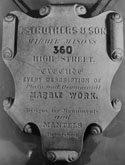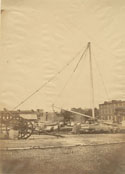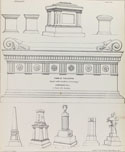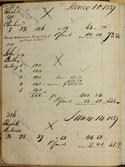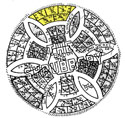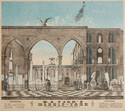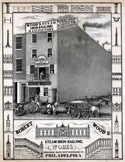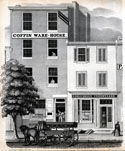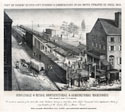The Grave Lot
For many of Laurel Hill’s early lot owners, bonds of sentiment joined home and tomb. Both arenas were discussed as havens for the family in an urbanizing society. Both were also targets of unprecedented consumer spending – typically on industrially produced goods. Three miles southeast of the cemetery, merchants selling monuments, mantels, iron fences, and outdoor furniture set up shop in the Spring Garden district. More discerning (or wealthy) customers might seek out center-city marble mason John Struthers. His firm’s famous work helped him afford one of Laurel Hill’s grandest lots.
Antonio Zeno Shindler, artist. Laurel Hill Cemetery, Philadelphia (ca. 1850). The Museum of Fine Arts, Boston. Gift of Maxim Karolik.
Designed by architect William Strickland and executed by the firm of John Struthers and Son, the Alfred Miller tomb and its meticulously planted lot occupy the foreground of this painting. In the distance, the cemetery's first greenhouse appears behind an evergreen. This is the only known depiction of the building, which had originally been part of Joseph Sims's estate.
Bartlett & French, photographer. Laurel Hill Cemetery (ca. 1868). Gift of John A. McAllister.
Private monuments, fences, and plantings gave Laurel Hill a dense, busy, and vaguely domestic appearance by mid-century.
John Moran, photographer. Warerooms of Baird's Monumental Works (ca. 1864).
John Baird ran the largest marble yard in Spring Garden and, perhaps, in the nation during the middle of the 19th century. His outfit made early use of steam saws and reputedly consumed 15,000 cubic feet of Italian marble a year. (See also Baird's broadside advertisement below).
Sign for John Struthers & Son. Photograph of museum object on deposit at the Atwater Kent Museum from the Historical Society of Pennsylvania.
James E. McClees, photographer. J. Struthers & Son Marble Yard (1858). Gift of John A. McAllister.
Using a jib crane, Struthers employees sent off marble blocks to be carved into monuments or dressed into building materials. John Struthers’ son, William, ran the 42-year-old concern by this time.
John Jay Smith and Thomas Ustick Walter. A Guide to Workers in Metals and Stone. Philadelphia: Carey and Hart, 1846.
Smith handily recycled designs from Laurel Hill’s 1844 Guide in this cheaply printed pattern book. Most prominent are the tombs of Joseph Lewis (top) and Isaac Hull, both executed by the Struthers firm. Below them are monuments to William Birch and Oscar Douglas (second and third from left) designed by an architect – John M. Hamilton – who listed himself at the Struthers’ business address in the late 1840s.
Sales book of Laurel Hill Cemetery. Laurel Hill Cemetery.
The middle entry on the left shows John Struthers paying $535.00 for 642 square feet of ground in Laurel Hill’s Shrubbery Section. This was a staggering sum in 1837 and it did not include the cost of subsequent adornments or funerals.
Map, survey, and photograph of the Struthers Family lot. Laurel Hill Cemetery.
Enclosed by a granite coping but shorn of its fence, the Struthers lot has lost some of its above-ground grandeur. But the space alone – able to accommodate eighteen burials to date – testifies to John Struthers’ means and foresight.
Robert F. Reynolds, artist. Robert Wood’s Railing, Architectural & Ornamental Iron Works. Philadelphia: Wagner & McGuigan, ca. 1851.
Wood’s firm supplied the most sculptural and ornate ironwork on Laurel Hill lots at mid-century. (See also broadside advertisements below).
W. H. Reese, lithographer. H. S. Tarr’s Marble Yard. Philadelphia, ca. 1858.
Tarr’s list of references includes architect and Laurel Hill friend Thomas U. Walter as well as cemetery manager Frederick Brown.
W. H. Rease, lithographer. N. Helverson Undertaker. Philadelphia: Wagner & McGuigan, 1846.
Unlike the up-market Schuyler, Helverson specialized in ready-made coffins. Most but not all of Laurel Hill’s customers would have considered such discount goods beneath them.
Alfred M. Hoffy, lithographer. View of Robert Buist’s City Nursery & Greenhouses. Philadelphia: Wagner & McGuigan, 1846.
Nationally known nurseryman Robert Buist sold plants to Laurel Hill’s managers and customers.



